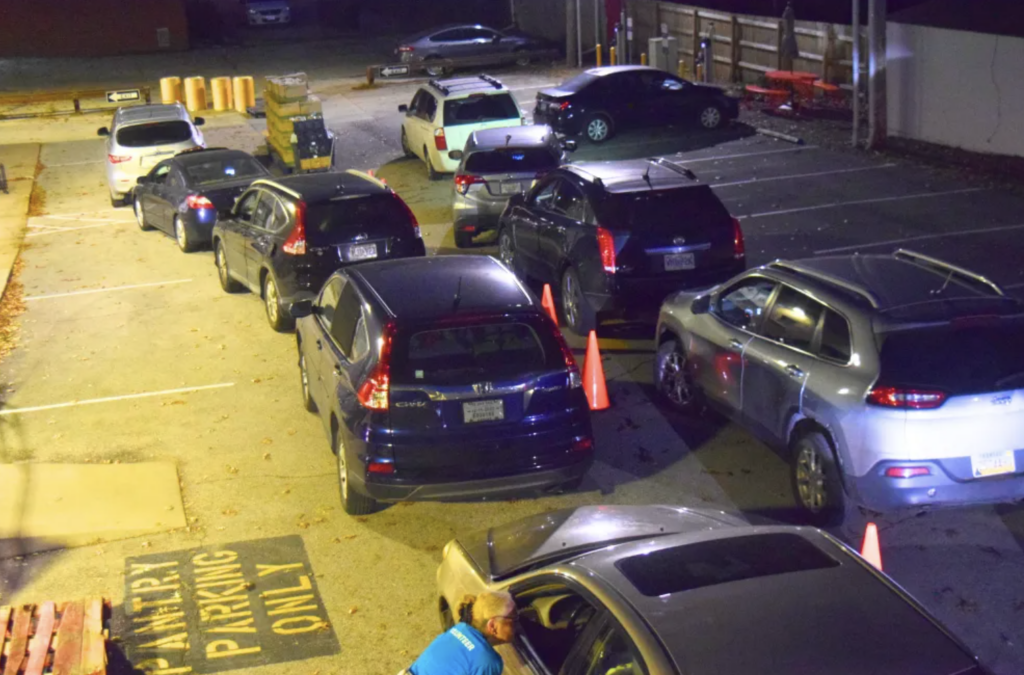‘We can’t keep food on the shelf’: KC food pantries struggle to keep up ahead of holidays
As SNAP benefits are restored, food pantry workers assess the damage. Supply is low, demand remains high and uncertainty about future federal cuts leaves families wondering what comes next.

Volunteers collect food for the pantry at Redemptorist Social Services Center in Kansas City (Thomas White/The Beacon).
Kisha Tivis heard about an emergency food distribution event at Jewish Family Services the day her family’s SNAP benefits were supposed to arrive but didn’t. The moment she clocked out from her job as a caregiver, she drove over, hoping for the chance to grab a box of food.
She joined a line of cars snaking around the block, temporarily causing a traffic jam on 63rd Street, when her phone rang.
“Mama, I’m hungry,” cried a young voice over the speakerphone. “Where are you? I’m hungry!”
It was her 9-year-old daughter. Her youngest called when hunger outlasted her patience.
“I know baby, I know,” Tivis said. “I’ll be there shortly … I’m trying to get some help right now.”
Takeaways
- Food pantry demand doubled during the SNAP disruption and government shutdown.
- Government funding cuts are hurting food bank supply.
- Food insecurity is at a 10-year high, as one in seven people need food assistance.
The 38-year-old mother of five hung up. She said there was nearly nothing to eat at home. Without her food benefits and with hungry mouths waiting, she had few options but to seek the pantry’s help.
She wasn’t alone.
Nearly 1 million people in Kansas and Missouri missed food assistance payments in November. SNAP — the Supplemental Nutrition Assistance Program, often referred to as food stamps — provides nine meals to every one that a community food pantry provides nationwide. As a result, a massive void needed to be filled while the program was offline during the 43-day federal government shutdown.
Benefits have slowly been restored in recent weeks. But food banks absorbed a surge in demand during the program’s weeks-long disruption amid a record-length federal government shutdown.
Now they stare down a new problem.The recent scramble for food stripped pantry shelves just as food banks enter their busiest season.
Put plainly, supply is low when demand is high. A typical business could simply raise prices to rebalance the market. But a food bank doesn’t have that luxury since they deal in basic sustenance for those in need.
Food pantry workers say current trends — in place even before the most recent rush on food — are unsustainable, and those in need of food assistance face an uneasy future as they confront ever-rising costs.

Food pantry demand soars
Harvesters is the food bank that helps supply food pantries and community kitchens throughout the region.
Sarah Biles, director of communications at Harvesters, said food insecurity was already at a 10-year high before the government shutdown and disruption to the SNAP program. But during that time, there was a torrent of need at the food bank’s network of partners.
“We were seeing about double the number of people coming to our pantries and mobile distributions,” Biles said. “So very overwhelming. In fact, some people were having to be turned away.”
During the rush on food pantries, Biles said that Harvesters invested $500,000 from donors to purchase additional food for their community food network. That food was snapped up by pantries within days.
Lenny Jones, vice president and state director of SEIU Healthcare in Missouri and Kansas, said some of his health care support staff union members qualify for SNAP benefits and the disruption hit them directly.
“It has been very difficult for many of our members,” Jones said. “We reached out to connect those in need with services because this is not something that folks normally talk about.”
Jones said he directed his members to support resources like the Working Families’ Friend, and some had to seek out food pantry help for the first time.

Christina Crenshaw, a pantry coordinator at Redemptorist Social Services Center, said she’s seen new faces lately. In the past, she’s personally helped 10 to 15 people a day. But that number shot up to about 40 on several recent days.
“We had a lot of new clients,” Crenshaw said. “Some were scared or panicking because the government would say, ‘Hey, you’re gonna have to lean on your pantries to get the food to have your needs met.’ So of course, when the community hears that they reach out to the pantries.”
Minnie O’Grady, the Northland Food Pantry manager for Metro Lutheran Ministry, said she’s also seen a huge increase in need and can barely keep food on hand.
“We stock the shelves and we turn around to get more,” O’Grady said. “But when we turn back to the shelf, the food’s already gone.”
O’Grady said the pantry just had a record month and their biggest food distribution day ever. But she also said that the need has been on a steady climb over the past 10 months.
“We’ve been seeing an increase of nearly 10% per month,” O’Grady said, describing the change in demand for food at her pantry this year as “exponential growth.”

Evaporating supply
While surging demand has raided shelves, food pantry supply was already in peril.
In March, the U.S. Department of Agriculture (USDA) cut $500 million in food commodities bound for food banks nationwide. For Harvesters, that meant 41,000 cases of meat, cheese, milk and other staples vanished. Some orders were even canceled while already loaded on trucks.
Biles said that the 41,000-case order that was canceled earlier this year wasn’t the only setback. All told, Harvesters in 2025 has lost out on almost 3 million pounds of high-quality food compared to last year. Harvesters has replaced much of the lost food with lower-quality substitutes.
Cuts since the beginning of the year have been “very, very significant,” O’Grady said. “We were getting around six pallets of commodities food a month and that went down to three.”
Biles said that the cuts came through one funding stream within The Emergency Food Assistance Program (TEFAP). That stream, funded by the USDA’s Commodity Credit Corp., had been a lifeline for food banks that allowed them to purchase specific foods.
“Really high-quality food was coming through that particular piece of the program,” Biles said. “That arm of the TEFAP program is gone, at least for the time being.”
Biles said that another arm — called Section 32 or bonus TEFAP — has helped fill in some holes but isn’t the same quality. “Bonus TEFAP” pays farmers for surplus agricultural products and gives them to food banks. While this is helpful, she said it is inconsistent month to month and almost never includes meat, cheese or milk.
“We were getting higher-quality food like proteins and dairy,” Biles said. “With this Section 32, it’s just whatever might be out there that’s excess.”
For O’Grady, the cuts meant her Northland pantry no longer typically receives animal proteins.
“There have been very many days recently that we just don’t have any meat,” O’Grady said.
Biles also said Harvesters is slated to lose about 1 million pounds of fresh Kansas produce “straight from the farmers’ field” due to another cut to the Local Food Purchase Assistance Cooperative Agreement Program. The program was federally funded until last year when Kansas stepped in to fund it, but that state funding will run out at year’s end.

Uncertainty ahead
Jones, whose union members include health care support staff ranging from certified nursing assistants to housekeepers, said the government cuts that have strained workers, SNAP recipients and food banks are just part of what’s to come.
He said most of his members who qualify for SNAP have gotten their full food benefits back, but not all.
“It’s left them with kind of this unease,” Jones said. “This sense that this is not something that can be counted on.”
He pointed to the Trump administration’s budget bill and noted pending work requirements for SNAP recipients — along with cuts to health care — coming up in the near future.
“What we just saw … was a glimpse of what’s to come,” Jones said before criticizing the budget bill. “I do think part of this was just a wake-up call to the more significant long-term damage that’s going to happen over the next couple of years if this is not stopped.”
The additional pending cuts to the social safety net come as prices for everything from food and housing to health care and child care have risen faster than wages.

“Everything is going up these days in general,” said Tivis. “Some people can’t afford all of that, like I’m supposed to juggle all this around and be happy that I’m working for nothing?”
Biles says that just because SNAP benefits have been restored doesn’t mean the food problem is instantly fixed.
“Food insecurity is everywhere,” said Biles. “You don’t see it necessarily because it’s not an outward thing. … But one in seven people and one in six children are food insecure. So someone you interact with in your community is someone who needs food assistance.”
This article first appeared on Beacon: Kansas City and is republished here under a Creative Commons Attribution-NoDerivatives 4.0 International License.![]()




